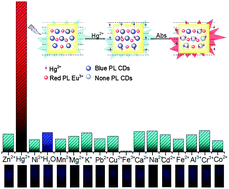Fabrication and application of a ratiometric and colorimetric fluorescent probe for Hg2+ based on dual-emissive metal–organic framework hybrids with carbon dots and Eu3+†
Abstract
A novel highly fluorescent hybrid (Eu3+/CDs@MOF-253) has been synthesized based on metal–organic frameworks (MOFs) by encapsulating optical active carbon dots (CDs) and Eu3+. The as-prepared fluorescent-functionalized MOFs not only maintained the excellent optical properties of CDs and Eu3+ to give dual-emission but also have good stability in an aqueous solution. It was further used as a novel fluorescent probe for detecting Hg2+. The relative fluorescence intensity ratio (IEu/ICD) increased linearly with increasing Hg2+ concentration in the 0.065–150 μM range with a 13 ppb detection limit. The possible mechanism is discussed. This study represents a new approach for the fabrication of ratiometric and colorimetric Hg2+ fluorescent sensors, as it highlights the opportunity of existing MOFs encapsulated CDs and Eu3+ sensitizing, simultaneously. In addition, removal of Hg2+ from a solution can also be achieved by the fluorescent MOF hybrids.


 Please wait while we load your content...
Please wait while we load your content...